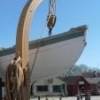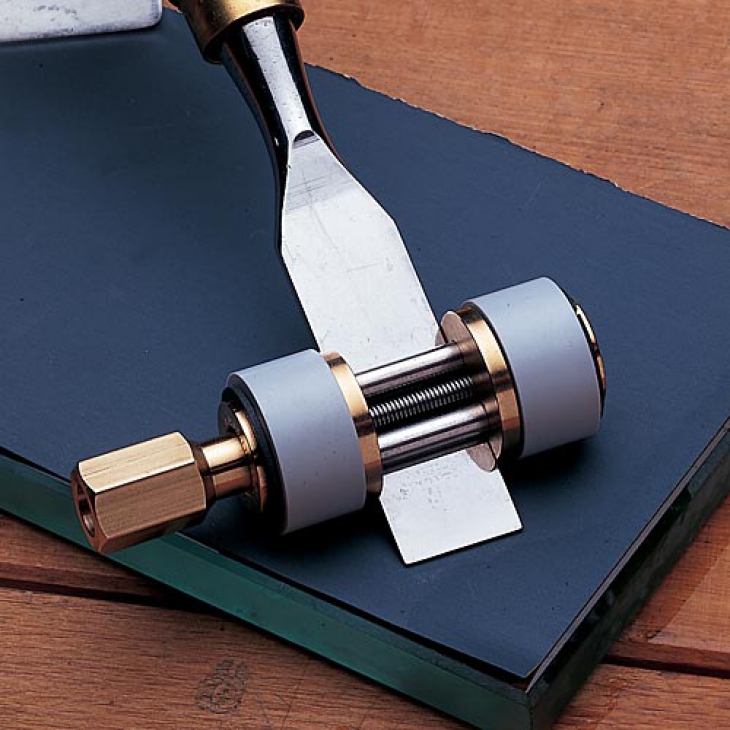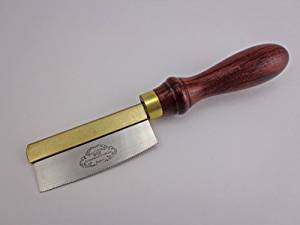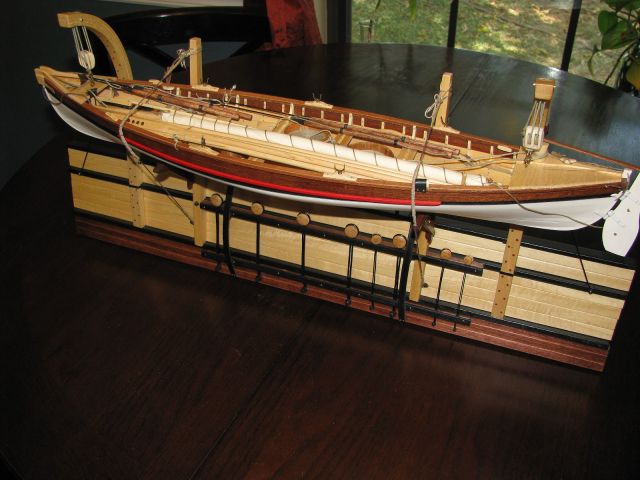-
Posts
449 -
Joined
-
Last visited
Content Type
Profiles
Forums
Gallery
Events
Everything posted by Landlocked123
-
Hi Dave, I'm one of the guys who uses honing guides. I use a Veritas guide (Lee Valley) for larger chisels and plane blades with Japanese water stones. I've recently been using Kell guide, below, for chisels from 1/2 to 1/16 inches (some shop made). It's pricey, but works really well and has the feel of a very finely made tool. I keep my water stones in a Tupperware tub, with a bit of chlorine bleach, on top of a cookie sheet lined with some non-slip cabinet liner I pilfered from my wife. It a pretty compact and storable sharpening station. Best, John Kell Shapening Guide Link: http://www.garrettwade.com/kell-british-made-deluxe-honing-guides-gp.html
-
Les, CA dissolves with acetone, but it's nasty stuff. Be sure use gloves, have a lot of ventilation and avoid splashing it on yourself. Just immerse the PE in the acetone for a few minutes and the pieces should come apart easily. Be sure to clean the pieces very well before soldering. Best, John
-
Bruce, I've equipped the Dremel saw with a cogged belt and it has plenty of torque. In my experience there are lots of times where you want to nibble away at a cross cut and being able to take a "bigger bite" would be advantageous. To me, the issue Jud raises makes the most sense. I will take Mark's advise and check out what MM offers. John
-

Power Tools for a Fully Framed Build
Landlocked123 replied to ChrisLBren's topic in Modeling tools and Workshop Equipment
Hi guys, I guess it come down to using the right tool for the right job. Thank, John -
Hi Guys, Before I invested in a high quality carbide stacked dado blade set for my big saw, I had this gadget which you would place on the arbor, which, when rotated, would create a variable degree of blade wobble to cut dados. I was thinking that if I got a 3/16" thick washer and filed it down so it would be 3/16th on one edge and 1/16 on the other, I could get a dado cut of 1/8th" plus the blade kerf on my Dremel table saw. I need some input here. Is this a good, bad, or crazy idea? Thanks. Best, John
-

Power Tools for a Fully Framed Build
Landlocked123 replied to ChrisLBren's topic in Modeling tools and Workshop Equipment
Hi Guys, I don't know if this is off topic but since we're talking about milling I thought I'd give it a shot. I have a Delta bench top drill press and was wondering if I invested in a proxxon x-y table and a few milling bits, would it be possible/useful for milling small jobs in wood? A Sherline is out of the question right now and I'm basically kit-bashing for my next step with some minor scratch building. We're not talking about TFFM here. What do you think? Thanks. Best, John PS - if the moderator wants to move this to a new topic, fine with me. J. -
E&T - A better question is did Ed smelt the iron to make the chain! Ed - unbelievably fantastic. You not only set the bar but give us tools, steps, and instruction on how someday we might hope to achieve something close. You have my KUDOS! Thanks, John
- 3,618 replies
-
- young america
- clipper
-
(and 1 more)
Tagged with:
-
Hi Mark, The build is looking great!!!! And though it's taken awhile, your patience and willingness to rework bits has paid off. One thought is that it might help to think like the French. First about women, second about food and lastly about the business at hand. Best, John
-
Hi Chuck, A forensic pathologist? It has it's good points, your patients are pretty easy going, they don't talk back much, and never sue. On the other hand, it's tough to get paid......they tend to be a bunch of deadbeats! Sorry, I couldn't help myself. Best, John
- 1,051 replies
-
- cheerful
- Syren Ship Model Company
-
(and 1 more)
Tagged with:
-
Mike, The more I look at what you've accomplished the more impressed I am. I love the look of the build, the color of the wood, and especially your craftsmanship. The fact that you do this in the corner of your living room is astounding. Equally astounding is the complete disaster area I call my work shop in my basement. I generally don't let folks down there because, like the Bermuda Triangle, they'll never find their way out.
- 968 replies
-
- hahn
- oliver cromwell
-
(and 1 more)
Tagged with:
-
Julie, One more point in favor of modern technology is that PVA is easily released with the application of isopropyl alcohol. Best, John
-

Can i live without a BYRNES TABLE SAW
Landlocked123 replied to shihawk's topic in Modeling tools and Workshop Equipment
Hi Julie, I use the Crown Veneer Saw and a steel straight edge. The saw blade is extremely thin with very fine teeth with no set. It's quite well made, works very well, and is another "fix" for my tool addiction. It's available on Amazon for about $20. Best, John Ps. I looked at the Festool site and besides being insanely expensive they don't appear to sell any bench top power tools suitable for model ship building. As for using a 10" TS to mill wood for model ship building, without impracticality thin kerfs, the waste factor is enormous. BTW, Jim's saw is very precise, runs as quietly and smoothly as a fine sewing machine, and has the power of a Hemi. J. -
HI Mike, I love this build and your workmanship is absolutely first rate!! Can I ask where you found those small scrapers from a few posts back. I've been looking for some and have not had any luck. Thanks. Best, John
- 968 replies
-
- hahn
- oliver cromwell
-
(and 1 more)
Tagged with:
-
Hi Julie, I'm catching up on your build and had a couple of thoughts regarding the problem you had with the CA. First, you can debond CA by soaking the joint with acetone. It's nasty stuff but It works. Second, instead of using shellac or varnish, try bee's wax. You can buy little bricks of it at most of the sites that supply stuff for model boat building. To make a paste, chop it up into small pieces, put in a small far and cover it with turpentine. It takes a day or two, but it will soften the wax up. It is also useful to treat the ropes used for rigging. Best, John
-
Thanks David and Vincent, I appreciate your input. I hope that over time more builders will add their thoughts. At some point it would be nice to hear about relative characteristics, e.g. which is more bendable for the same sized plank, walnut or cherry? castillo or holly? I also thought I would share my inspiration for this build. It is in the Gallery of Completed Models and built by "greatgallions". He really fif a great job. Best, John
-
Hi All, Over the years I have read numerous topics and posts regarding many aspects on the differences in the characteristics of different species of wood. I read a lot how different woods cut, finish, the colors and other variables. I don't recall seeing any topics on which species bend the easiest, or which can be bent into the tightest curves. Which can be bent just using heat and which need special handling. In my next build, the New Bedford Whale Boat, I plan on doing substantial substitution on the kit supplied basswood. I plan on only painting below the wales and to use different woods of contrasting color for other areas. So far I plan to use, cherry, walnut, holly, castillo box, and maple. I would like to use one of the last three for the ribs but I have no idea of which can be bent into the required curve. I'm sure this is an area in which a lot of folks out there have a great deal to share. Thanks in advance. Best, John
-
Toni/Mark Do you guys have any idea if the accuriser II (which MM says are for its own saw only) will fit on the Dremel? Thanks. Best, John
-
Hi Danny, I'm catching up myself. I have to join the chorus and say it's another first rate job. I also want to add my thanks. You not only give something to aspire to, but show us how to do it. BTW, what's next in shipyard? Best, John
- 268 replies
About us
Modelshipworld - Advancing Ship Modeling through Research
SSL Secured
Your security is important for us so this Website is SSL-Secured
NRG Mailing Address
Nautical Research Guild
237 South Lincoln Street
Westmont IL, 60559-1917
Model Ship World ® and the MSW logo are Registered Trademarks, and belong to the Nautical Research Guild (United States Patent and Trademark Office: No. 6,929,264 & No. 6,929,274, registered Dec. 20, 2022)
Helpful Links
About the NRG
If you enjoy building ship models that are historically accurate as well as beautiful, then The Nautical Research Guild (NRG) is just right for you.
The Guild is a non-profit educational organization whose mission is to “Advance Ship Modeling Through Research”. We provide support to our members in their efforts to raise the quality of their model ships.
The Nautical Research Guild has published our world-renowned quarterly magazine, The Nautical Research Journal, since 1955. The pages of the Journal are full of articles by accomplished ship modelers who show you how they create those exquisite details on their models, and by maritime historians who show you the correct details to build. The Journal is available in both print and digital editions. Go to the NRG web site (www.thenrg.org) to download a complimentary digital copy of the Journal. The NRG also publishes plan sets, books and compilations of back issues of the Journal and the former Ships in Scale and Model Ship Builder magazines.





